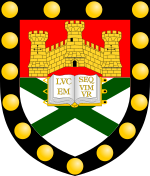 Coat of arms | |||||||||||||
| Motto | Latin: Lucem sequimur | ||||||||||||
|---|---|---|---|---|---|---|---|---|---|---|---|---|---|
Motto in English | "We Follow the Light" | ||||||||||||
| Type | Public | ||||||||||||
| Established | 1838 – St Luke's College 1855 – Exeter School of Art 1863 – Exeter School of Science 1955 – University of Exeter (received royal charter) | ||||||||||||
| Endowment | £48.6 million (2023)[1] | ||||||||||||
| Budget | £633.5 million (2022/23)[1] | ||||||||||||
| Chancellor | Sir Michael Barber | ||||||||||||
| Vice-Chancellor | Lisa Roberts | ||||||||||||
| Visitor | Charles III ex officio | ||||||||||||
Academic staff | 3,760 (2022/23)[2] | ||||||||||||
Administrative staff | 3,255 (2022/23)[2] | ||||||||||||
| Students | 32,825 (2022/23)[3] | ||||||||||||
| Undergraduates | 23,480 (2022/23)[3] | ||||||||||||
| Postgraduates | 9,345 (2022/23)[3] | ||||||||||||
| Location | , England 50°44′10″N 03°32′06″W / 50.73611°N 3.53500°W | ||||||||||||
| Campus | Streatham – 350 acres (140 ha)[4] St Luke's – 16 acres (6.5 ha) | ||||||||||||
| Colours | Green and white | ||||||||||||
| Affiliations | |||||||||||||
| Website | exeter | ||||||||||||
 | |||||||||||||
The University of Exeter is a research university in the West Country of England, with its main campus in Exeter, Devon. Its predecessor institutions, St Luke's College, Exeter School of Science, Exeter School of Art, and the Camborne School of Mines were established in 1838, 1855, 1863, and 1888 respectively. These institutions later formed the University of Exeter after receiving its royal charter in 1955.[6][7] In post-nominals, the University of Exeter is abbreviated as Exon. (from the Latin Exoniensis), and is the suffix given to honorary and academic degrees from the university.
The university has four campuses: Streatham and St Luke's (both of which are in Exeter); and Truro and Penryn (both of which are in Cornwall). The university is primarily located in the city of Exeter, where it is the principal higher education institution. Streatham is the largest campus containing many of the university's administrative buildings.[8] The Penryn campus is maintained in conjunction with Falmouth University under the Combined Universities in Cornwall (CUC) initiative. The Exeter Streatham Campus Library holds more than 1.2 million physical library resources, including historical journals and special collections.[9]
It was one of the pre-World War II local university colleges granted university status in the 1950s, as part of the second wave of civic universities. In 2012, Exeter joined the Russell Group of research-intensive UK universities.[10] It is also a member of Universities UK, the European University Association, and the Association of Commonwealth Universities and an accredited institution of the Association of MBAs (AMBA). The annual income of the institution for 2022–23 was £633.5 million of which £118.7 million was from research grants and contracts, with an expenditure of £604.0 million.[1]
- ^ a b c "Financial Statements for the Year to 31 July 2023" (PDF). University of Exeter. p. 73. Retrieved 19 December 2023.
- ^ a b "Who's working in HE?". www.hesa.ac.uk. Higher Education Statistics Agency.
- ^ a b c "Where do HE students study? | HESA". hesa.ac.uk. Higher Education Statistics Agency.
- ^ "The University of Exeter – Hospitality Services – Visitors – Events". Archived from the original on 17 December 2006. Retrieved 31 January 2007.
- ^ "About the University of Exeter, Cornwall Campus". Archived from the original on 16 September 2007. Retrieved 31 January 2007.
- ^ "History of the University". University of Exeter. Archived from the original on 14 December 2016. Retrieved 1 April 2012.
- ^ "Exeter Memories – Exeter University". Exeter Memories. Archived from the original on 17 June 2017. Retrieved 9 April 2012.
- ^ "University guide 2012: University of Exeter". The Guardian. London. 10 May 2009. Archived from the original on 24 November 2020. Retrieved 2 April 2012.
- ^ "Library | Library | University of Exeter". www.exeter.ac.uk. Archived from the original on 9 December 2020. Retrieved 21 September 2018.
- ^ "The Russell Group". The Russell Group. Archived from the original on 17 April 2012. Retrieved 1 April 2012.